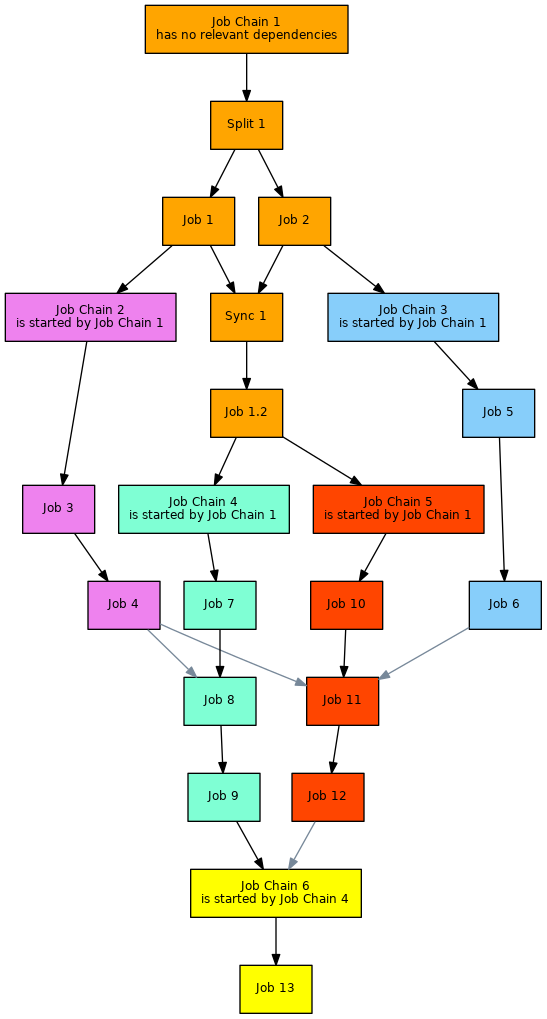Scope
- Use Case:
- Consider the situation where:
- A job chain is to start at a number of parallel job chains
- Subsequent jobs in started job chains check if jobs from parallel chains completed successfully.
- Usually a split & sync pattern is used for similar use cases, however, synchronizing includes that both jobs have to be completed.
- Instead the current use case is about check and control if a job of a parallel chain has completed without forcing both jobs to run synchronously.
- Consider the situation where:
Solution
- Download: final_chain_job_chain_history.zip
- Extract the archive to a folder in your JobScheduler installation named
./config/live. - The archive will extract the files to a sub-folder
parallel_job_chain_control. - Note that you can store the sample files in any folder you like.
Pattern

Implementation
Components
- The solution contains six job chains:
JobChain1runsJob1andJob2in parallel.- On successful completion of
Job1thenJobChain2is run - On successful completion of
Job2thenJobChain3is run
- On successful completion of
JobChain2runsJob3andJob4JobChain3runsJob5andJob6JobChain4runs after successful completion ofJobChain1JobChain4runsJob7,Job8,Job9Job7runs 1stJob8runs onceJob7andJob4have run successfully
JobChain5runs after successful completion ofJobChain1JobChain5runsJob10,Job11andJob12Job10runs 1stJob11runs onceJob10,Job4andJob6have run successfullyJob12runs onceJob11has completed successfully
JobChain6runs onceJob9andJob12have completed successfully
Usage
- The first job
split1set some pairs of parameters in a pre-processing to control which job tells that it is successfully completed.- The first parameter of the pair is a flag which is used for a later check if the dependent jobs are successfully completed.
- The value of this parameter is initialised with "0" and will be modified by the dependent jobs with "1".
In above example these are
job4_successfully_completed=0which will be checked byJob8andJob11job6_successfully_completed=0which will be checked byJob11job12_successfully_completed=0which will be checked byJob13
- The second parameter of the pair describes which job commits which job chains that it has successfully completed.
- You need to specify all job chains, in which the order can be located with respect to the checking jobs
- The current job chain (here
JobChain1) is always the first in the list. - The job chains can specify with its absolute path or relative to the current job chain.
In above example these are
job4_commits_completion_to="/parallelExecutionExample/JobChain1;JobChain4;JobChain5"
job6_commits_completion_to="/parallelExecutionExample/JobChain1;JobChain5"
job12_commits_completion_to="/parallelExecutionExample/JobChain1;JobChain4;JobChain6"
- The first parameter of the pair is a flag which is used for a later check if the dependent jobs are successfully completed.
- The dependent jobs (here
Job4,Job6Job12- in all job chains which are specified in the "
commits_completion_to" parameter - where the value of the "
successfully_completed" parameter is set to "1"
- in all job chains which are specified in the "
- The jobs which wait of its dependent jobs have a pre-processing where they check the corresponding "
successfully_completed" parameters- These jobs have a task parameter "
dependent_jobs" where a list of its dependent jobs are specified. - In above example these are
Job8 : dependent_jobs="Job4"Job11: dependent_jobs="Job4;Job6"Job13: dependent_jobs="Job12"
- These jobs have a task parameter "
The above described pre- and post-processings include the attached
control_parallel_execution_of_job_chains.jsfile so that you have following small configuration
See also
- How to check the job chain history for previous job chain and order runs
- How to add a condition to check previous jobs before the execution of the current job chain